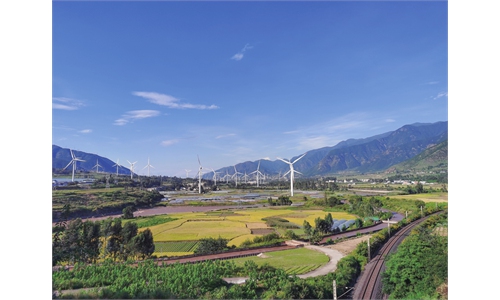
A renewable energy base in Sihong County, East China's Jiangsu Province is seen on Sunday as wind turbines spin. The base can generate 650 million kilowatt-hours of power annually, with tax revenue of 50 million yuan ($7.7 million). The annual income of fishery breeding amounts to 45 million yuan, and tourism income to 20 million yuan. A total of 640,000 tons of carbon emissions can be avoided every year. Photo: VCG
China's national carbon market has been running smoothly in the first month of trading, with cumulative quotas reaching 7.02 million tons and total transactions standing at 355 million yuan ($54.78 million), an official told a press conference on Wednesday.
In the first compliance cycle for the national carbon market for the power generation industry, 2,162 enterprises in the coal-fired power sector were included, covering 4.5 billion tons of carbon dioxide emissions, according to Minister of Ecology and Environment Huang Runqiu.
Huang added that trading price rose from 48 yuan per ton on the first day to 51.76 yuan at the close on Tuesday.
The Ministry of Ecology and Environment will work with relevant departments to improve the operation of the national carbon market, said Huang.
The market started online trading on July 16, a significant step to help the country reduce its carbon footprint and meet emissions targets.
Carbon emissions by more than 2,000 power companies covered in the first batch of trading are estimated to exceed 4 billion tons per year, making the market the world's largest in terms of the volume of greenhouse gas emissions.
Huang said that industry coverage is expected to be broadened on the basis of sound market operation within the power generation industry.
More high-emission industries will gradually be incorporated, and trading options, methods and entities will be extended in order to improve the market's overall performance.


